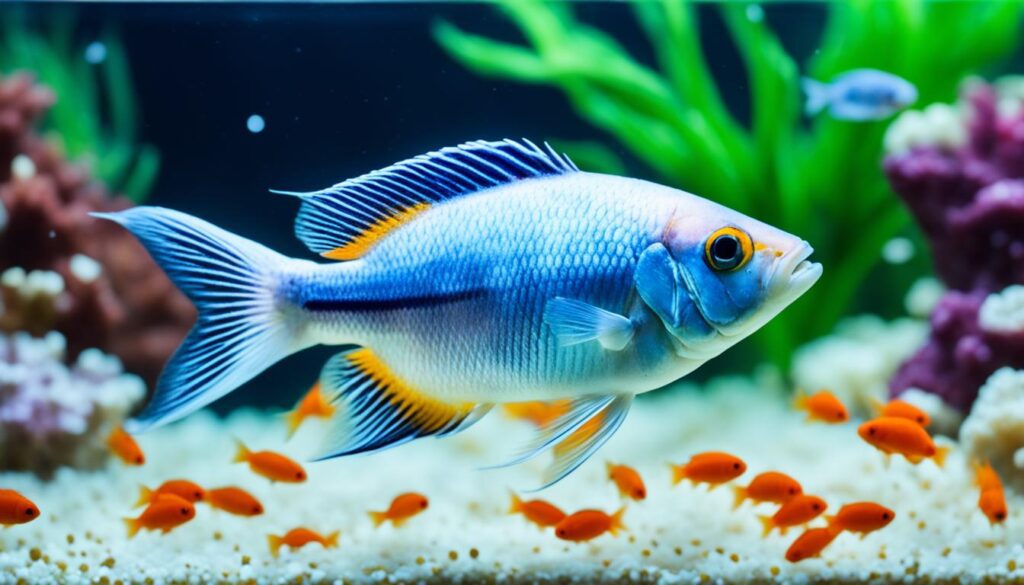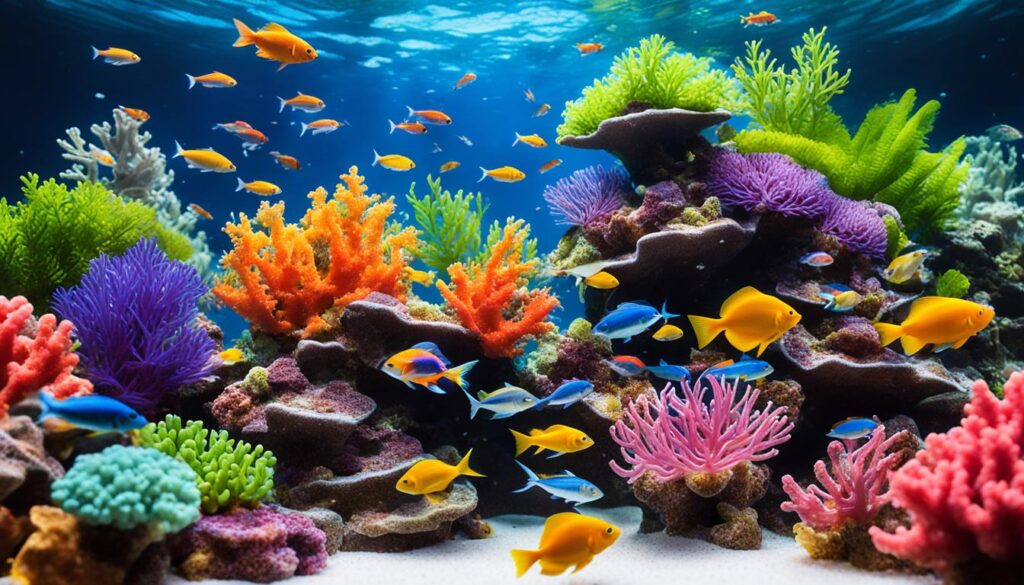My quest to keep a healthy aquarium led me to find the aquarium salt benefits. It helps with gill function and adds needed electrolytes. Many use ich treatment methods like increasing water temp to 80-84 degrees Fahrenheit. They also add aquarium salt at a dose of 1 tablespoon per 5 gallons of water. Keeping the tank well-maintained is key to the fishes’ wellbeing. It allows them to live in the best conditions.
But, everything that shines in the fish tank isn’t always gold. I’ve watched some ich strains resist common treatments. And too much aquarium salt can harm the plants and disrupt the tank’s balance. Balancing effective treatment with harmony in the tank is both science and art. It’s a journey of patience, learning, and listening to the community’s wisdom.
Introducing Aquarium Salt to My Aquatic Family

When I started using aquarium salt, my main goal was to help my betta fish stay healthy. I had to learn a lot about aquarium salt application to keep every living thing in my tank safe. This included the beneficial bacteria needed for the nitrogen cycle and plant safety.
Using salt the right way brought big health benefits for my fish. They became more resistant to diseases and breathed better. Bettas, which are very sensitive to changes, benefited a lot from this careful approach. Here’s what I did:
- I never used table salt and chose special aquarium salt without bad additives.
- I carefully figured out the right amount of salt to avoid harming my tank friends.
- I regularly checked on my fish to see if they were happy or stressed, and adjusted the salt as needed.
Aquarium salt was not only great for my bettas but for everyone in the tank. It made dangerous substances like nitrite less harmful and helped everyone stay calm during water changes or when the pH dropped.
Impact |
Without Proper Cycling |
With Salt and Proper Cycling |
|---|---|---|
Fish Health |
Poor – Higher stress and disease occurrence |
Improved – Healthier, stress-resistant fish |
Biological Cycle Duration |
4-6 weeks |
10-14 days with products like Seachem Stability |
Beneficial Bacteria Growth |
Slow |
Boosted by added salt, accelerating the cycle process |
With a lot of study and careful use, adding aquarium salt has changed my tank for the better. By balancing the salts right, I’ve kept my bettas and other fish safe. I’ve also helped the biological filter that every healthy aquarium needs.
The Unexpected Perils: When Aquarium Salt Backfires

In my aquarium journey, I’ve seen the good in using aquarium salt. It’s simple and effective for many. But, it’s vital to know when it could make things worse. This is especially true when fighting ich, as ich can resist treatment and stress the fish more.
Resistance of Ich to Salt and Heat
Ich, or White Spot Disease, affects almost all aquarium fish. Despite this, aquarists like me have tried using more salt and heat to fight ich. But these methods are not always sure to work. Some ich strains resist salt and heat, making our efforts less successful.
Raising the tank’s temperature to about 86°F (30°C) is common. It should speed up ich’s lifecycle, letting fish fight it off quicker. But, this can backfire if the ich likes the heat, worsening fish stress and lowering their immunity.
How Elevated Temperatures Can Worsen Ich Outbreaks
Heating the tank does speed up the ich lifecycle. Yet, it’s tricky. Too much heat can stress the fish and make the ich worse. We need to find the perfect balance to help, not harm, our fish.
Using UV sterilizers with careful temperature control can help. This approach keeps the fish safer. It lessens the need for extreme heat to control ich.
Using heat and salt needs careful watching of the fish. It’s key to adjust if the fish seem stressed or are getting sick. Fighting ich isn’t just about beating the disease. It’s about making sure our fish stay happy and healthy.
Triumphs with Aquarium Salt: Fish Health Victories

I’ve learned a lot through my fish tank adventures, especially about keeping an aquarium healthy. Using aquarium salt wisely has been key. It helps keep the water just right and my fish and corals happy. Let’s look at some ways this simple salt can make a big difference.
Prevention of Parasites and Enhancement of Slime Coats
Aquarium salt is great at fighting off parasites. I’ve seen way fewer ich outbreaks in my fish because of it. The salt makes it tough for parasites to survive. Besides, it boosts my fish’s slime coat. This coat is their shield against bad stuff.
Reduction in Nitrate Intake During Tank Cycling
Using aquarium salt helps manage nitrates, which is tricky but important. When setting up new tanks or maintaining old ones, the right salt levels keep harmful nitrates away from my aquatic buddies. It’s super important for my more delicate fish that can’t handle lots of nitrates.
Water Change Cycle |
Salt Mix Percentage |
|---|---|
1st Change |
25% new, 75% old |
2nd Change |
50% new, 50% old |
3rd Change |
75% new, 25% old |
4th and Subsequent Changes |
100% new salt |
By following these steps, my fish are healthier and my tanks look amazing. Crystal clear water and lively fish really show off why taking care with aquarium salt is smart. It proves that a bit of salt goes a long way in making a happy underwater home.
Navigating the Nuances: Dosage and Usage Best Practices
As an aquarist, I’ve learned a lot about aquarium salt dosage and its correct use. It’s key to improving fish health. Getting the right amount is like ensuring the best electrolyte balance for fish. A common start is one tablespoon of salt for every five to seven gallons of water. I carefully adjust this based on the specific needs of my tank’s inhabitants. This is important because different fish have various tolerance levels to salt.
The Importance of Concentration Levels for Salt Usage
Having the right salt concentration is essential for a stable aquarium. My experience includes both successes and failures. For example, I adjusted the specific gravity in my brackish-water tank from 1.004 to 1.010. This was done using a digital refractometer for precision. But, being too hasty once led to a big mistake. It resulted in back-siphoning ammonium nitrate and losing many fish. These experiences taught me the value of patience and taking preventive steps.
Among my aquatic pets, snails are particularly challenging. They’re very sensitive to salt. Their tolerance varies by species, size, and age. So, I adjust the salt dosage to keep them safe. This helps avoid harmful effects on these creatures.
Combining Aquarium Salt with Other Treatments
I’ve found combining aquarium salt with other treatments to be effective, especially against stubborn pathogens. This includes using methylene blue or specific antibiotics for a separate fish bath. It’s crucial to dissolve the salt first before adding it to the tank. This avoids shocking the aquatic life. These combined treatments help keep my tank healthy.
They work well for tougher snail species too, which some research shows can handle lower salt levels. They also keep my marine biosediment substrate balanced. The phrase “it’s a marathon, not a sprint” perfectly describes my approach. I take gradual, careful steps to protect my underwater world.








